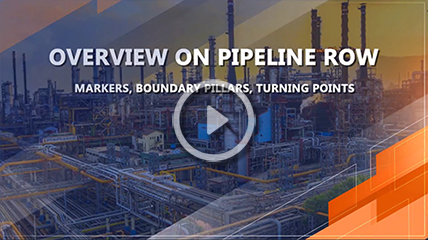Pipeline Safety
IndianOil is committed to public safety, protection of the environment, and operation of its facilities in compliance with all applicable rules and regulations of the country. All of its pipelines fall under the regulatory framework of P&MP Act 1962 (with all latest amendments) and governed by safety standards of Petroleum and Explosives Safety Organisation (PESO) and Oil Industry Safety Directorate (OISD). IndianOil is proud of its safety record and follows many regulations and procedures to monitor and ensure the integrity of its pipelines.
- Pipeline operating conditions are monitored 24 hours a day, 7 days a week by personnel in control centres using Supervisory Control and Data Acquisition (SCADA) system. This system gathers data such as pressures, volume & flow rates and the status of pumping units & valves. Whenever operating conditions change, an audio-visual alarm warns the operator on duty and the condition is investigated. Both automated and manual valves are strategically placed along the pipeline route to enable the pipeline to shut down immediately and sections can be isolated quickly as and when required.
- Visual inspections of the entire right of way of IndianOil pipelines are carried out on daily basis through foot patrolling by pipeline security guards. Above ground pipeline markers and boundary pillars are displayed along the right-of-way (ROW) to alert the public and contractors regarding the existence of the pipeline.
- Regular interactions with villagers are maintained through conducting village awareness programs to sensitize them about pipeline safety and informing them about actions to be taken by them in case of any emergency so that they can act as first responders to the incident in case of requirement. Other activities like free medical check-up camps, tree plantation drives, provision of drinking water facilities, street lighting, construction of school buildings etc. in villages are also carried out to keep them engaged and to be in touch with IndianOil.
- Most of the CSR activities of Pipelines division are centred towards villages nearby to ROW.
- Internal inspections are conducted periodically by passing sophisticated computerized equipment called Intelligent Pigs through the pipelines to detect anomalies or defects that could compromise the integrity of the line.
- Cathodic protection is a technology designed to protect pipelines from external corrosion through the use of electrostatic current. The small electrical current is applied to our pipelines, which already have an external protective coating.
- Public awareness programmes of IndianOil are designed to prevent third-party damage to its pipelines. The leading cause of pipeline accidents is third-party damage caused by various types of digging and excavation activities.
- IndianOil has well-designed emergency preparedness and planning measures in place to effectively handle various types of untoward incidents in the pipeline. The Corporation also maintains coordination with other industry members and government agencies (mutual aid partners).
- IndianOil has well documented Emergency Response Disaster management Plan for each station and Pipeline section.
Pipelines are the most efficient and safest mode of transport and delivery of natural gas and petroleum products. This is inherently safer than other modes of transportation such as rail, shipping and road transport. While the amount of natural gas and petroleum products being used in the country continues to increase, the industry's safety performance is also excellent even after such a rapid increase in the length of the pipeline network. Pipelines ensure a reliable supply of natural gas to industrial, commercial and domestic users; petrol to operate our cars and two-wheelers; high-speed diesel to transport & power generation sectors, jet fuel for nation's commercial and defence aircraft and LPG as a cooking as well as auto fuel.



